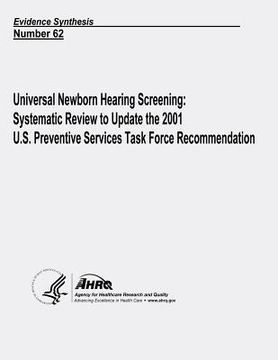Compartir
Universal Newborn Hearing Screening: Systematic Review to Update the 2001 U.S. Preventive Services Task Force Recommendation: Evidence Synthesis Numbe (en Inglés)
U. S. Department of Heal Human Services
(Autor)
·
Agency for Healthcare Resea And Quality
(Autor)
·
Createspace Independent Publishing Platform
· Tapa Blanda
Universal Newborn Hearing Screening: Systematic Review to Update the 2001 U.S. Preventive Services Task Force Recommendation: Evidence Synthesis Numbe (en Inglés) - And Quality, Agency for Healthcare Resea ; Human Services, U. S. Department of Heal
S/ 115,30
S/ 192,16
Ahorras: S/ 76,87
Elige la lista en la que quieres agregar tu producto o crea una nueva lista
✓ Producto agregado correctamente a la lista de deseos.
Ir a Mis Listas
Origen: Estados Unidos
(Costos de importación incluídos en el precio)
Se enviará desde nuestra bodega entre el
Lunes 15 de Julio y el
Miércoles 24 de Julio.
Lo recibirás en cualquier lugar de Perú entre 2 y 5 días hábiles luego del envío.
Reseña del libro "Universal Newborn Hearing Screening: Systematic Review to Update the 2001 U.S. Preventive Services Task Force Recommendation: Evidence Synthesis Numbe (en Inglés)"
This systematic evidence review updates a prior review for the U.S. Preventive Services Task Force (USPSTF) on universal newborn hearing screening (UNHS) to detect moderate to severe permanent, bilateral congenital hearing loss (PCHL). In 2001, based on results of a prior systematic evidence review, the USPSTF concluded that the evidence was insufficient to recommend for or against routine screening of newborns for PCHL during the postpartum hospitalization (I Recommendation). The USPSTF provided additional specific conclusions about the evidence. They determined that methods of screening using otoacoustic emissions (OAEs) and auditory brainstem response (ABR) are highly accurate for identifying PCHL in newborns, and UNHS leads to earlier identification and treatment of infants with PCHL. They found that evidence was inconclusive regarding whether earlier treatment resulting from newborn screening leads to clinically important improvement in speech and language skills at age 3 years and beyond because existing studies had design limitations. The USPSTF considered that earlier identification and intervention may improve the quality of life during the first year of life, and prevent regret by the family over delayed diagnosis of PCHL, but limited data addressing these benefits existed. They were not able to determine whether potential benefits outweighed the potential harms of false-positive tests. This update focuses on critical evidence gaps that were unresolved at the time of the 2001 recommendation, and utilizes the format and methods of the prior systematic evidence review. The Joint Committee on Infant Hearing (JNIH), comprised of representatives from audiology, otolaryngology, pediatrics, education, and state speech and hearing programs, provides position statements and establishes practice standards for early identification, intervention, and follow-up care for infants and young children with hearing loss. According to the JCIH, hearing screening should identify infants at risk for specifically defined hearing loss that interferes with development. The targeted hearing loss for UNHS programs is permanent sensory or conductive hearing loss averaging 30 to 40 decibels (dB) or more in the frequency region important for speech recognition (approximately 500 through 4000 Hertz [Hz]). The focus of UNHS is on congenital as opposed to acquired or progressive hearing loss that may not be detected in the newborn period. The term "hearing impairment" is commonly used outside the U.S. instead of "hearing loss." This systematic review updates the evidence from the prior 2001 USPSTF review for the following key questions: 1. Among infants identified by UNHS who would not be identified by targeted screening, does initiating treatment prior to age 6 months improve language and communication outcomes? 2. Compared with targeted screening, does UNHS increase the chance that treatment will be initiated by age 6 months for average risk infants? For high risk infants? 3. What are the adverse effects of UNHS and early treatment?

